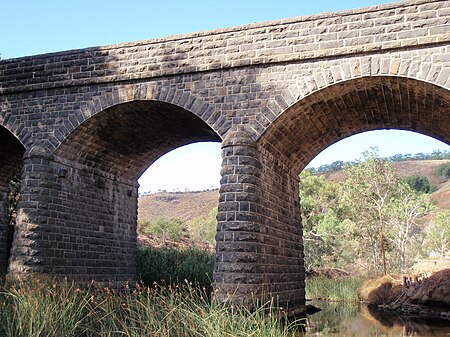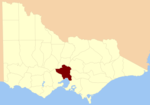Bulla Bridge
1869 establishments in AustraliaAustralian bridge (structure) stubsBridges completed in 1869Buildings and structures in the City of HumeRoad bridges in Victoria (state) ... and 5 more
Stone arch bridges in AustraliaStone bridges in AustraliaTransport in the City of HumeUse Australian English from May 2012Victoria (state) building and structure stubs

Bulla Bridge is a four span bluestone arched bridge over Deep Creek in the town of Bulla, north east of Melbourne. It was constructed in 1869 by McBurnie and Ramsden, for the Shire of Bulla to a design of Scottish-born engineer John C Climie and replaced a timber bridge built in about 1859. The bridge is 126 feet long and comprises four spans each of 27 feet. It is associated with a c.1843 road cutting and early ford which was on the main road to the Victorian gold fields.The picturesque setting has attracted a number of artists and photographers including the woodcut by Eveline Winifred Syme in the 1930s, and numerous historic photographs.
Excerpt from the Wikipedia article Bulla Bridge (License: CC BY-SA 3.0, Authors, Images).Bulla Bridge
Bulla Road, Melbourne Bulla
Geographical coordinates (GPS) Address Nearby Places Show on map
Geographical coordinates (GPS)
| Latitude | Longitude |
|---|---|
| N -37.6312 ° | E 144.8011 ° |
Address
Bulla Road
Bulla Road
3428 Melbourne, Bulla
Victoria, Australia
Open on Google Maps










